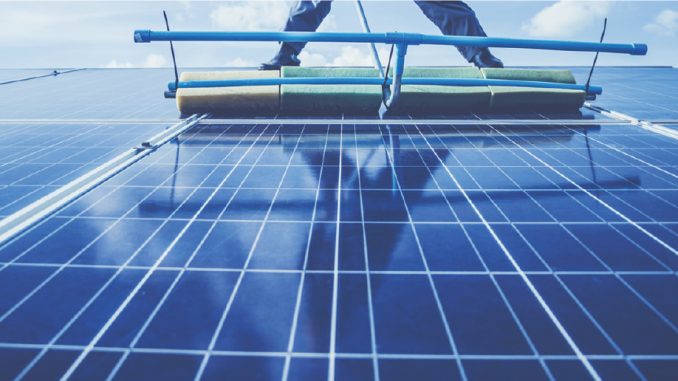
In the dry cleaning method of cleaning solar modules, no water is used and solar panels are cleaned using air pressure and dry brushes. Dry cleaning solutions are gaining traction owing to water availability issues in many project locations across the world. In this white paper, “PV Module Cleaning – Market Overview and Basics”, Dr Nicoletta Ferretti of PI Photovoltaik Institut Berlin AG describes four types of dry cleaning techniques – truck mounted, semi-automated, portable and fully automated. Renewable Watch presents them in brief…
Truck mounted
Truck-mounted cleaning systems comprise a brush attached to a truck or vehicle that drives between the PV module rows. To avoid PV module damage, each machine has its system for controlling the pressure of brushes on the PV modules. The truck-mounted cleaning system necessitates the use of at least one worker, who must be professionally trained. The worker is seated in a vehicle, typically equipped with air conditioning.
Semi-automated
Semi-automated cleaning devices must be installed in the beginning while setting up a PV module mounting table. After completing one PV module table, the device must be carried and placed on to the following PV module table by hand. In most cases, the machine features a sensor that detects the end of the row and returns automatically. To move the devices from one table row to the next, most semi-automatic systems require two workers. Cleaning is carried out automatically. Several companies offer semi-automated cleaning systems these days.
Fully automated
Fully automated devices are mounted on each row of a PV system and stored at a parking station on one side of each row. These devices are only programmed to go along a single module row. The majority of the devices are equipped with an error detection mechanism that assesses weather conditions before operating. Certain devices may be charged by their own PV modules while all fully automated products run with an onboard battery. Fully automated devices do not require manual labour for cleaning or positioning.
Portable robots
Portable robots move on the surface of PV modules and are up to 1 square metre in size. They can work independently, and have sensors and a control framework for recognising the end of the PV module surface and shifting bearing to clean one more piece of the module exhibit. Many commercially available devices are driven by a controller and manual inputs are required in such circumstances. When it comes to tilting angles, certain robots have restrictions, whereas others use a vacuum to stick to the PV module surface, allowing cleaning of modules with a larger tilt angle. Portable robots are a common solution for cleaning rooftop installations and trackers owing to their configuration.
Future technologies
In recent years, rapid advancements are being made in the solar module cleaning market. Innovative dry cleaning technologies such as drone cleaning and high voltage-based cleaning are being tested. Aerial Power developed the SolarBrush drone, which is mounted with a brush that sweeps dry dust and dirt from the surface of PV modules. It is easy to transport and takes a small number of people to operate. Using preprogrammed flight paths, the technology cleans up an entire solar PV system. A single individual can distribute up to eight different drones throughout the PV system. The drone can travel up to 35 degrees along a row of PV modules.
Meanwhile, Taft Instruments’ TAFT robots sweep dust and dirt away from PV modules using a high AC voltage electric field. As a semi-automated system, the robot clamps to the edges of the module using motor-driven rollers. The device electronics generate a high AC voltage, which is applied to conductors close to the PV module’s surface. Along the field line, the charged particles oscillate. Dust is pushed towards the edges of the PV module as the robot moves over it, and eventually falls off.
Net, net, given the rising demand for dry cleaning due to water conservation concerns, more such technology advancements can be expected in the future.


